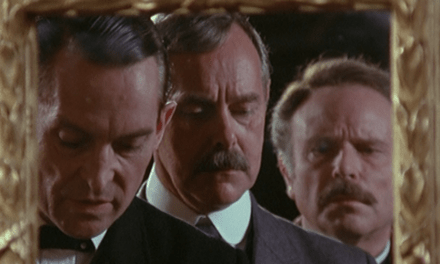At the moment I’m rather glad that I’m not teaching one of my favourite courses, ‘Contemporary Issues in Television Studies’. This was the kind of course in which you try and persuade students that learning about legislation, regulation, governance and institutional structures is not boring but actually more relevant (as viewers and aspirants to a television career) than almost anything else they will do. Thanks to willing volunteers from the industry the course was often great fun and much appreciated.
But now I’m not sure how to explain what is going on. I was away in Amsterdam for the run-up to George Entwhistle’s resignation as Director General of the BBC and, even though in my hotel room I had BBC 1 and 2 along with the usual news channels, I found it very hard to make sense of what was happening. At first, I thought that Newsnight had actually revealed the name of the accused, rather than sending viewers off to Twitter, and I missed Entwhistle’s disastrous encounter with John Humphreys. Now, partly thanks to John Ellis’s CST blog, I’ve a better idea about what the issues are but my usual capacity to generate instant opinions has deserted me, faced with endless comment on the role of the BBC Trust, the backstabbing among staff and the minutiae of the BBC upper and middle management structure. Do I think that Patten should go? I don’t know. Will Tony Hall (appointed as I write this) make a good DG? Let’s hope so. Can Maria Miller turn it round and become a half-effective DCMS Minister? Unlikely (although the experienced commentator Maggie Brown gives her a sympathetic write up in the RTS magazine Television). Will the patriarchal big beasts – Humphreys, Simpson, Paxman – seize the moment to reassert control of the news? Probably. Is the BBC once again a target for gleeful (post-Leveson) press and politicians? Undoubtedly. What will the impact of that be years down the line in terms of the BBC’s future? Discuss.
In the meantime, the consequences of the Savile revelations continue to swirl around. The furore has all the marks of a moral panic but there are real tragedies at its heart. What is yet to come we don’t know but anyone interested in an earlier example of children’s programmes being used as barely concealed cover should read Andrew O’Hagan’s account of the behavior of producers and presenters of children’s radio programmes in the post-war period (‘London Review of Books Vol. 34 No. 21, 8 November 2012 ‘Light Entertainment’). I found myself watching an old Top of the Popsepisode last week (not my fault I hasten to add). Obviously the BBC can’t now show those episodes featuring Savile but I later learnt that the original episode to be re-run had to be pulled because it featured another DJ who had just been held by the police over a non-Savile-related incident. So this was a ‘safe’ episode. It occurred to me while watching that, in the old days, the programme and Savile were ripe for a cultural studies analysis based on the Bakhtinian concept of carnival in which TOTP offered a space in which established conventions and behaviour could be turned upside down. Now the whole thing looks sinister – the organisation of space that forces the young female audience and DJs to snuggle up, the lack of barriers between performers and audience, Legs and Co writhing, the avuncular verbal attempts to whip up a storm and visual attempts to create a vaguely trippy feeling. And all the time the young audience moves around on cue, trying to hide the excitement at just being there with a veneer of teenage cool.
snuggle up, the lack of barriers between performers and audience, Legs and Co writhing, the avuncular verbal attempts to whip up a storm and visual attempts to create a vaguely trippy feeling. And all the time the young audience moves around on cue, trying to hide the excitement at just being there with a veneer of teenage cool.
Other things have been more cheering. Two ‘academic’ events centring on television proved effective in attracting a wider audience than usual. In the last event to be held at the Women’s Library, June Purvis talked about Cristobel Pankhurst and was followed by Vicky Bell and Helen Wheatley who talked about representations of suffragettes in Shoulder to Shoulder and Upstairs Downstairs respectively. Really good detailed papers benefited from a mixed audience of those primarily interested in history and those in television; I talked to at least two women in the audience who combined both and were currently working on scripts set in this period. The Women’s Library is to move to LSE and it’s to be hoped that its visual material and resources will not only be improved but built on in the coming years. The other event, organised by Royal Holloway’s Adam Gantz for the London Screenwriting Seminar, allowed me to discuss Bleak House (the 2005 ‘soap’ version) with Dickens expert Juliet John (author of Dickens and Mass Culture, 2010). Interestingly this too got a mixed audience of students, academics and current and former television practitioners, including a scriptwriter for EastEnders, which led to an informative and lively discussion. Both events were encouraging examples of the old practice/theory barriers coming down a bit and it struck me that scriptwriting (and adaptations perhaps) offer more possibility for that than the usual conversations with directors.
 And finally, I have returned to The Hour, series 2, on BBC2 and am starting on The Killing by watching series III. In The Hour, Romola Garai, despite her absurdly sexy office wear, is acting with such delicacy and grace that her male co-stars, Damien West and Ben Wishaw, struggle to keep up. And the Soho sets look great, relishing the lack of realism with a nod in the direction of British films of the 1950s. Once again the rather heavy signaling of what we know is going to happen (the Notting Hill Riots) is a bit of a problem but this feels like a series that is settling into good work. I was struck however that the driver in the British programme is, as usual, sadistic sex (with politics lurking in the background), while in The Killing it seems to be coalition politics (with sex lurking in the background). But, as with all my current issues in television, we wait to see what happens next and new developments may well have proved me wrong by the time you get (thanks for your patience!) to the end of this blog.
And finally, I have returned to The Hour, series 2, on BBC2 and am starting on The Killing by watching series III. In The Hour, Romola Garai, despite her absurdly sexy office wear, is acting with such delicacy and grace that her male co-stars, Damien West and Ben Wishaw, struggle to keep up. And the Soho sets look great, relishing the lack of realism with a nod in the direction of British films of the 1950s. Once again the rather heavy signaling of what we know is going to happen (the Notting Hill Riots) is a bit of a problem but this feels like a series that is settling into good work. I was struck however that the driver in the British programme is, as usual, sadistic sex (with politics lurking in the background), while in The Killing it seems to be coalition politics (with sex lurking in the background). But, as with all my current issues in television, we wait to see what happens next and new developments may well have proved me wrong by the time you get (thanks for your patience!) to the end of this blog.

Christine Geraghty is an Honorary Professorial Fellow at the University of Glasgow and an Honorary Research Fellow at Goldsmiths, University of London. Her publications on television include a contribution to the 1981 BFI monograph on Coronation Street; Women and Soap Opera (Polity, 1991); and My Beautiful Laundrette (I B Taurus, 2004). Her BFI TV Classic on Bleak House (2005) will be published in October 2012. Her BFI TV Classic on Bleak House (2005) was published in October 2012. She is on the editorial board of the Journal of British Cinema and Television and sits on the advisory boards of a number of journals, including Screen.





